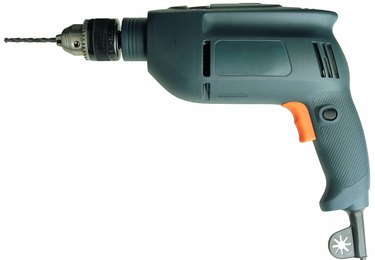A damaged, broken, or cracked ceiling joist can cause a ceiling to sag and should be repaired as soon as possible. If the problem worsens, it can cause the ceiling or upper floor to sag, crack the drywall covering on the ceiling and compromise the structural integrity of your home. Repair and reinforce a ceiling joist by affixing a new plank to the side of the joist. This process is referred to as "sistering."

Video of the Day
Things You'll Need
Sister Plank
Saw
Hammer Or Nail Gun
2 3/4-Inch Wood Screws
2 1/2-Inch Nails
Construction Adhesive
Drill
Step 1
Cut a plank to fit the length of the joist run. Use a plank that is the same size as the joists. Joists are typically 2 by 6 inches or 2 by 4 inches.
Video of the Day
Step 2
Drill pilot holes in the plank for screwing it to the joist. Drill a pilot hole every 12 to 14 inches.
Step 3
Apply construction adhesive to the side of the joist, affix the plank, and tack it in place by nailing just one nail at each end.
Step 4
Realign the joist if needed. If there is slight sagging, push up on the joist by wedging in a vertical board between the joist and the floor beneath. If your ceiling has drywall, place a horizontal scrap of wood between the top of the vertical board and the ceiling to serve as a buffer and to prevent a drywall puncture. A hydraulic jack may be necessary for extreme sagging. In this case, the entire drywall covering has probably already been damaged and will need to be replaced.
Step 5
Screw the plank to the joist. For extra strength, cross-brace boards can also be positioned between the plank and the nearest joist. Attach the cross-brace board by toe nailing (driving screws in at an angle) it to the joists.